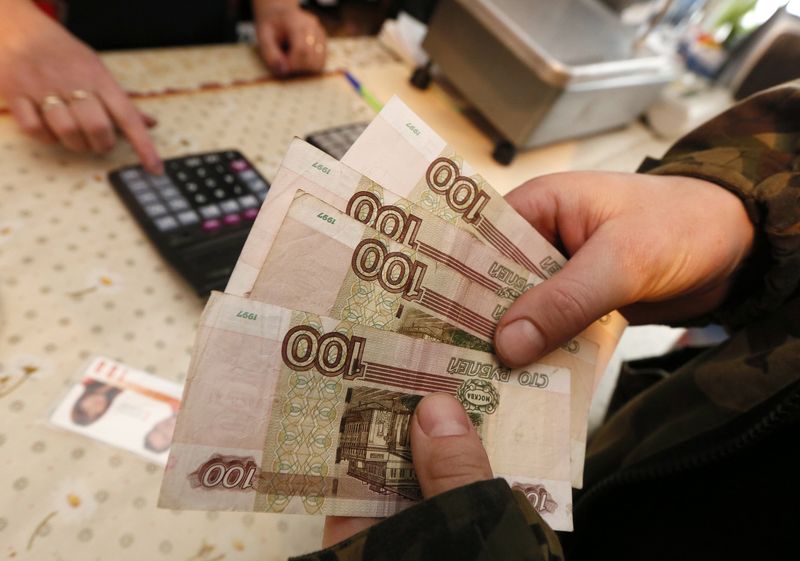By Alexander Winning and Oksana Kobzeva
MOSCOW (Reuters) - Russia may have to spend more than $40 billion (26.64 billion pounds) this year to avert a banking crisis, as the growing likelihood of a sharp recession threatens to pile extra costs on a sector suffering from Western sanctions over Ukraine and a plunge in the rouble.
Russian banks are seeing a deterioration in their loan quality, a rise in their risk management costs and increase in their cost of funding, and banking executives and analysts predict things are going to get worse.
This represents a major challenge to President Vladimir Putin, who took power 15 years ago in the ashes of a crisis that wiped out the financial system, and whose popularity partly rests on his reputation for restoring stability.
"We expect a contraction in the number of small, medium and large banks this year," Mikhail Zadornov, head of VTB 24, the retail arm of No. 2 bank VTB (MM:VTBR), said on Thursday. "It will be hard for all banks. The weakest will leave the market," he said.
Russia's central bank has already relaxed regulation of banks, and the government has pledged support of more than 1.2 trillion roubles ($19 billion) this year after spending more than 350 billion roubles in 2014. But analysts say this is a fraction of what is needed.
The anti-crisis measures will significantly add to pressures on Russia's international reserves and the budget, which is already forecast to run a deficit of up to 3 percent of gross domestic product this year, hurt most by a collapse in oil prices which is withering the country's export revenues.
"To preserve the status quo, banks may need far more capital than 1 trillion roubles," said Yaroslav Sovgyra, associate managing director for Moody's ratings agency in Russia.
"One trillion would boost their capital (adequacy ratio) by about 200 basis points. But on the other hand because of credit losses you'll see a reduction in capital by roughly 500 basis points."
One further problem is that the government's planned capital injection comes with strings attached: Russian banks are being asked to increase lending to core sectors of the economy by around 12 percent. That could further stretch their capital.
SLIPPERY SLOPE
The government is soon to distribute up to 1 trillion roubles of OFZ treasury bonds issued late last year to banks including VTB, Gazprombank
VTB and Gazprombank are also expected to receive money from the National Wealth Fund, a sovereign fund originally intended to support the pension system, of over 200 billion roubles.
Top bank Sberbank (MM:SBER) could also attract a subordinated loan of up to 600 billion roubles from the central bank, its main shareholder, or extend an existing loan from the regulator. It has said it is too early to talk about a new loan for now.
BNP Paribas estimates that Russian banks could need up to 2.7 trillion roubles ($42 billion) in additional capital to support lending and absorb credit losses.
Such figures would amount to almost 20 percent of planned federal budget expenditure this year.
Sberbank Chief Executive German Gref said last week that Russian banks would need to create about 3 trillion roubles of provisions this year should oil prices average around $45 a barrel.
Last month, the state spent 130 billion roubles to bail out the first major bank to fall victim to the rouble crisis, mid-sized lender Trust Bank, then ranked 15th biggest by retail accounts and 32nd by assets.
"If banks from the top 30 get into trouble, the government will have to save them at any price," said Armen Gasparyan, a banking analyst at Renaissance Capital. "It would be very painful for such a bank to go under, as it could spark a crisis of confidence in which the population withdraws deposits en masse and interbank lending rates spike."
Russian central bank deputy governor Mikhail Sukhov told Reuters he did not expect a wave of banking insolvencies, but that the current financial crisis could force those engaged in high-risk financial operations to leave the market.
So far, the central bank says non-performing loans were just 3.8 percent of banking sector assets at the beginning of December. But Moody's, which uses a different methodology, puts them at 7.5 percent already and says they could roughly double this year.

During the last financial crisis in 2008-2009, there was a time lag before the proliferation of bad loans appeared on balance sheets: at the start of 2009, they made up 3.8 percent of Russian banks' loan portfolios, but a year later this figure had risen to 9.6 percent.